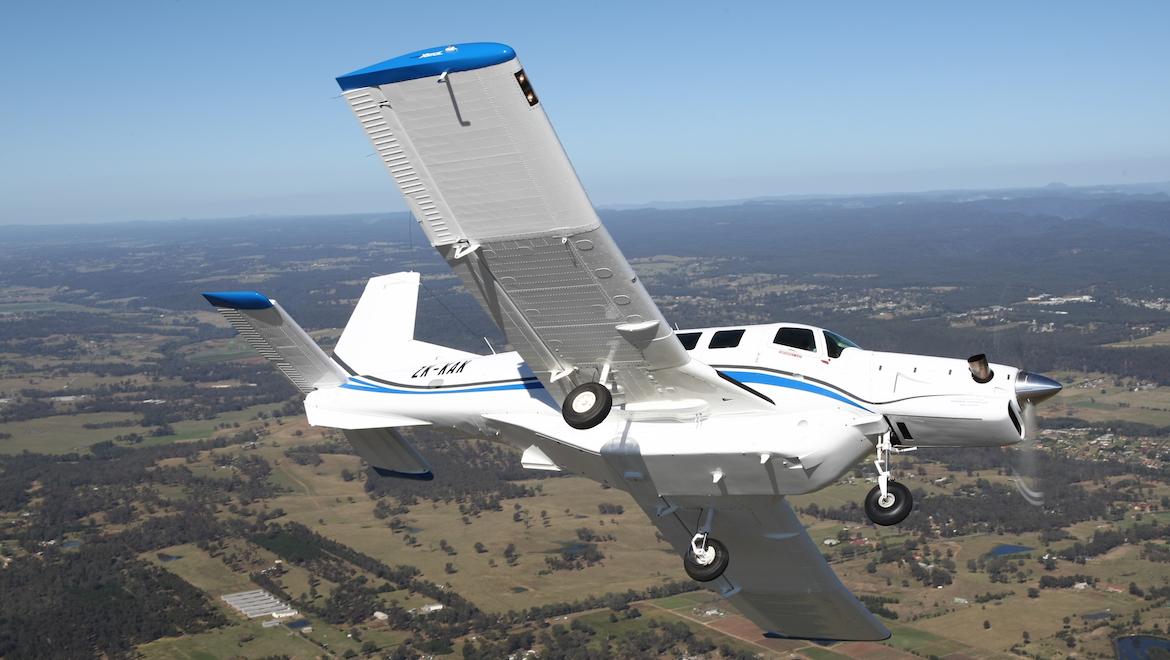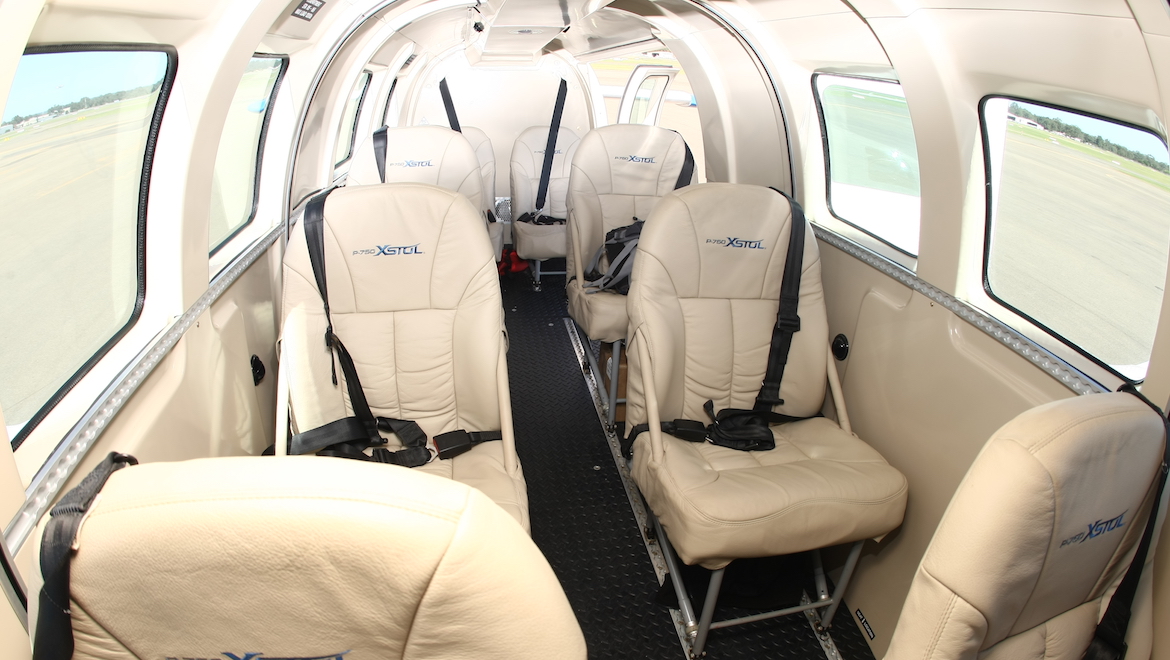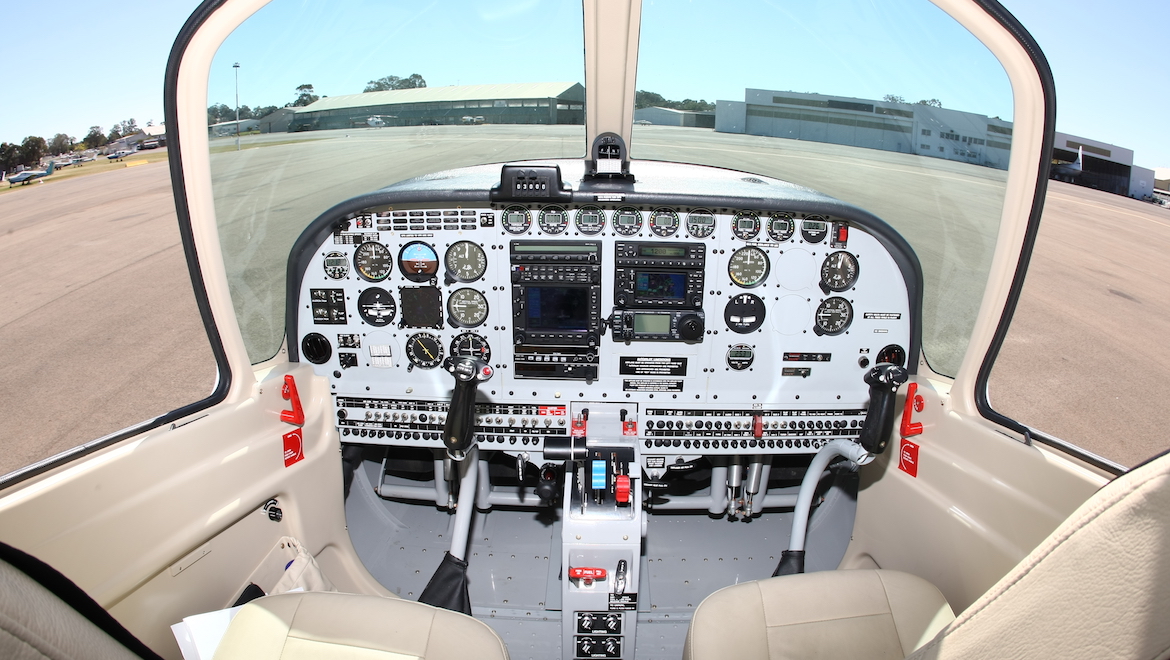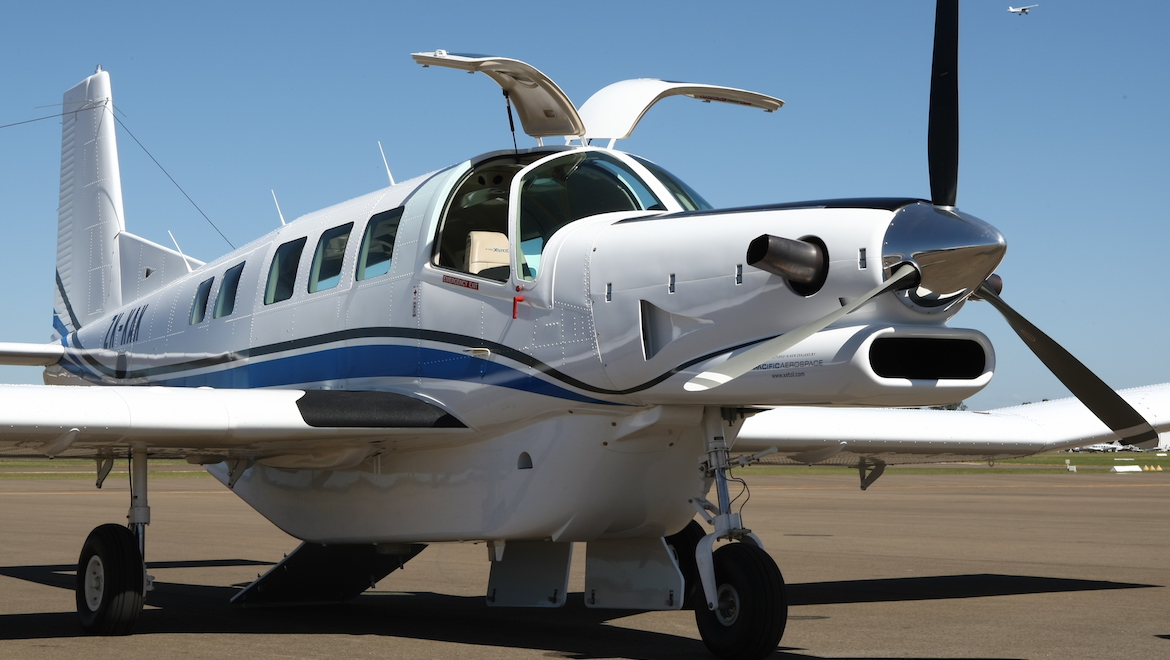This story from the Australian Aviation archives is from November 2009, when Owen Zupp took the Pacific Aerospace P-750 XSTOL on a flight test.

Beauty is said to be in the eye of the beholder and aircraft design is a classic case in point. The Royal Australian Air Force’s (RAAF) Caribou or the Airbus program’s “Super Guppy” have rarely been referred to as beautiful aeroplanes, but it is a different conversation when you speak of them in an operational sense. Sometimes it is the ability to perform that defines an aeroplane’s beauty, and the P-750 XSTOL is one such machine.
Origin of the Species
As Pacific Aerospace’s P-750 XSTOL sits on the ramp at Bankstown, it demands immediate attention. Surrounded by smaller piston singles, the P-750 sits high, almost dominant, with the prop of its lone Pratt & Whitney Canada PT6A-34 turboprop feathered and at the ready. Its sturdy fixed landing gear and thick high lift wing section with outer dihedral sends a message that this aircraft was born to work. And so it was.
The XSTOL’s roots go back to the 1950s when the Fletcher aircraft company designed and first flew the piston engined FU24 cropduster. It was an aerial agriculture aircraft with a difference as it possessed a tricycle undercarriage, the pilot sat in front of the “hopper” and its wing featured outer wing dihedral – characteristics that live on today in the P-750. The aircraft subsequently began production in New Zealand in the 1960s and evolved through the next decade to the larger Cresco turbine version. The next major step in the evolutionary process saw the fitting of the 750shp PT6A engine in 1992 and the renaming to the “Cresco 750”. This aircraft was the immediate predecessor to the P-750 and its latest manifestation, the XSTOL.
In half a century and building over 600 airframes (including the RAAF’s and RNZAF’s CT-4s) by Pacific Aerospace and its predecessors, many lessons can be learnt in aircraft production. The P-750 XSTOL has evolved from its Fletcher heritage and its design reflects a mixture of the rugged features required to get the job done. Yet these looks are most certainly deceiving as the aircraft is no longer confined to an aerial agriculture role. It is designated a “utility” aircraft and that term is as broad as the tasks that are met by the modern XSTOL. The aircraft is a workhorse and looks as such.
The aircraft has a proven record in parachuting, spraying, firefighting, freight, aerial survey and aeromedical roles. Such versatility is afforded by the its ability to operate off the shortest, most rugged airstrips to serve remote communities, and for skydiving a rapid climb to altitude to facilitate more jump sorties per hour than its competitors. Its broad side doors, 450kg capacity cargo pod and highly flexible centre of gravity envelope make the aircraft an ideal freighter.
The Airtest subject aircraft is configured in a 10-seat passenger arrangement and was en route from Pacific Aerospace’s Hamilton factory to Southeast Asia for use as a personal aircraft. Comfortable leather seats, generous headroom, large windows and the very acceptable cabin noise levels from the turboprop make this aircraft a real option for passenger operations. There are a variety of options for the XSTOL’s interior, and demonstrator pilot Guy Stevenson explains that they have even been decked out in an impressive corporate interior – the choice is yours. From the outside the XSTOL may not suggest such a role, but once inside it is easy to understand its suitability. After flying it, one is most certainly convinced.

Brute Bearing
At first glance, the XSTOL looks to be a brute, able to take whatever is pitched at it. This is further underpinned by an engine/airframe combination that is one of the cheapest and simplest to operate. Yet, on closer examination, the features that give it this brutish bearing each have very valid design reasons that grossly outweigh aesthetic considerations.
This is no more evident than in the wing and aerofoil design. It has a thick section that affords its high lift characteristics and short field performance. The upward raking of the outboard wing offers enhanced lateral stability and the large single slotted flaps spanning the inboard section facilitate a stall speed of a mere 58kt at max weight. As a result, at a MTOW of 3405kg this aircraft has a certified takeoff roll of only 220m and 364m to 50ft! Coming back to earth that landing roll is a mere 166m. It is easy to see why the “X” is for extra in XSTOL. But don’t be fooled, this aircraft will cruise comfortably at 140kt indicated.
The wings sit relatively low and the fuel cap location is well thought out with remote drum refuelling in mind. The undercarriage reflects years of “ag strip” operations, while the large cargo pod not only boasts three side doors for easy access, but a tailgate to the rear for loading longer items. For passengers and/or freight, there are large double doors on the rear left hand side. These doors can be substituted with a factory installed skydiving door for those who choose to disembark prematurely.
For the crew there are gull wing doors on both sides of the aeroplane. These doors are designed to “blow off” if opened in flight to permit rapid egress should there be an emergency during parachute operations. Once seated, the pilot has an excellent outlook both ahead and to the sides through generous glazing.
The cockpit is well equipped with a very clean and orderly layout. Immediately apparent is the large “stick-style” control column. It has a distinct military feel to it and is home to the push-to-talk switch as well as elevator and aileron trim. There is new generation glass on the centre panel encompassing avionics and a moving map, while conventional toggle switches for systems line the lower edge of the panel. Engine instruments line the top of the panel and have a digital display surrounded by an arc of LEDs. The arc of lights commence as green and become amber when operating limits are exceeded. While this is the same as a conventional dial, its placement and illumination permits a ready reference for power settings without having to drop the eyes back into the cockpit. This is ideal for low level and critical short field operations.
The cabin is well appointed. While this particular aircraft is destined for predominantly passenger operations, the sidewalls boast discreet freight rails and placards for maximum loads in the different zones. The XSTOL can also change between roles readily by stowing the seats in an aft compartment, freeing the aircraft up to become a dedicated freighter. This aircraft is as much about versatility as it is utility.

Taking Flight
The time had come to take the P‑750 into the air and see if it delivers as much in flight as its design offers to the operator.
The obvious red fuel selector on the centre pedestal is easily accessible from both seats. Engine start is very simple which is no surprise to anyone who has operated the PT6A-34, and in no time we are sitting at idle awaiting the camera ship. Bringing the propeller out of feather we move off and taxi using the direct linkage nosewheel steering that is very simple to manage. Pre-takeoff sequences are very straightforward, lending themselves to the rapid turn-around of spraying and jump operations.
Lined up and cleared for takeoff, the power lever is advanced against the brakes to have a first up look at the short field performance with three on board and a 545kg fuel load. Soon after brakes release, the airspeed indicator comes alive and the aircraft feels ready to fly. At around 40kt and 80m the nose lifts off and we take to the sky. Accelerating to 60kt, the aircraft is climbing at well in excess of 1000ft/min and we level off at the thousand foot mark before the runway’s end. Impressive!
With the nose down and cruise power set, we set course for the training area to meet the camera ship. The aircraft has quickly accelerated to 140KIAS and it is easy to see why this aircraft easily boasts a cruise TAS of 140kt while burning just under 200 litres an hour, offering five hours’ endurance with no reserves.
Best of all, the aircraft feels so very easy to fly. Initially, the nose attitude was deceptively low, but once the great forward view was accepted and the aircraft was trimmed, it just sat there. In the cruise it felt as docile as a slab-winged Cherokee, making it very easy to fly. Conducting upper airwork revealed much of the reason why – the aircraft has phenomenal low speed handling.

It should come as no surprise that any aircraft possessing such an aerial agriculture heritage and short field performance is at home in the low speed regime. Yet having cruised at a good pace in this comfortable and relatively quiet cabin, one forgets about the “workhorse traits” of this aeroplane. Furthermore, its rate of roll is very pleasing and the entry is as crisp as you could ask for, rolling from limit turn to limit turn in the opposite direction in only a couple of seconds.
Stalling the aircraft is impressive at the other end of the spectrum. In both clean and approach configurations, the aircraft displayed textbook pre-stall buffet before developing a minimal rate of descent. A slight tendency to drop a wing was easily countered and despite endeavouring to stir the control column around its pivot while stalled, the aircraft remained fundamentally controllable.
Recovery was conventional with power and attitude, but why stop there? Maintaining a relatively high nose attitude and advancing the power lever, the XSTOL actually accelerated beyond the stall and climbed away at 60kt. The main effect to counter was the strong torque as the PT6A powered up. Through all of this manoeuvring and engine handling, the telltale LEDs continued to steer me towards the correct power settings without having to drop the eyes and hunt for numbers. In terms of performance, the sound low speed handling facilitates the XSTOL’s impressive takeoff and landing figures, but for everyday operations it infers a very high margin of safety for anyone flying the aeroplane.
Established in the circuit area, the aircraft’s stability made it simple to fly in the pattern. Furthermore, its broad speed envelope made it very easy to fit in with the lighter aircraft traffic. One can imagine that whether number two to a Tomahawk on final, or being sweated upon to keep the speed up on an ILS, the XSTOL is able to fit in with ease.
Flying around a 90kt base and 80kt final, the aircraft has a heap of margin over the stall. Once trimmed, it sits on speed and on slope with minimal pilot input right down to the flare. The back pressure to enter the flare is quite significant and some old hands put in a measure of aft trim on short final to assist. Even so, the stick force is very manageable and the aircraft touches down on its broad track undercarriage without event. Lifting a lever on the power lever, it is pulled back through Beta range and into reverse. From touchdown to full stop, I’d estimate it was less than 100m. Even a flapless approach and no reverse is very miserly with the runway. Circuit after circuit, the aircraft performed predictably and right on the money before departing for the return to Bankstown.
En route, it was hard to get over how straightforward this aeroplane was to fly, yet how much it had to offer. In all phases it was very stable, but not at all heavy on the controls. Slowing down, entering the GAAP and conforming to the circuit could not have been easier, yet this aircraft has genuine performance to offer. The XSTOL goes a long way towards actually defining the term ‘utility’ in relation to aircraft.

Looks can Deceive
Having flown the P-750, one comes away with a mixture of impressions beyond the tremendous capability of this aeroplane. It is without doubt an aircraft you MUST fly to fully appreciate. To assess it based upon the book figures and appearance would tend to collar the aircraft into a stereotype workhorse role. It is so much more.
While the XSTOL is undoubtedly multi-task capable it is not to be tarred merely with its cropduster heritage or pigeonholed for its exceptional short field performance. This is a comfortable and impressive passenger aircraft that is very simple to fly well. Those qualities, that have evolved through necessity, serve to complement its all round performance.
In the P-750 XSTOL is an aircraft capable of a multitude of tasks, operating out of virtually any airfield you can nominate. This is a very well thought out aeroplane grown from decades of experience. It possesses a blend of performance and versatility that enables it to achieve its goals where others often can’t. It may look like a brute on the ramp, but there’s a finely-tuned machine lying beneath.
[vc_gallery interval=”0″ images=”78899,78897,78895,78894,78900″ img_size=”750×420″ title=”The Pacific Aerospace P-750 XSTOL in pictures (Photography by Paul Sadler)”]
This story first appeared in the November 2009 edition of Australian Aviation. To read more stories like this, subscribe here.













